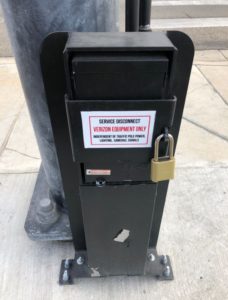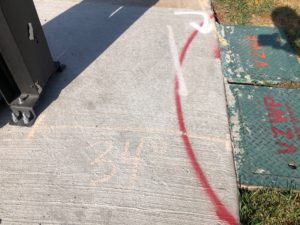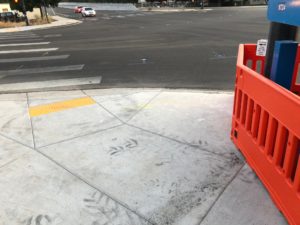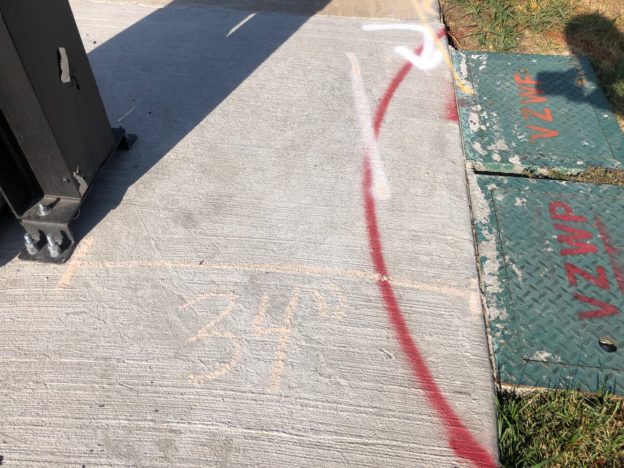by Don Kostelec
September 7, 2019
Beware: Wireless phone companies are coming to invade sidewalks in order to make a profit at the expense of sidewalk users, especially people with disabilities.
It appears that public agencies are failing to do their due diligence to inspect and regulate them properly.

While taking a walk to clear my mind during my daughter’s latest hospital stay, I came across newly-installed 5G technology from Verizon Wireless. This one is along Emerald Street in Boise. It is at a pedestrian crossing that links destinations within a medical services district and is adjacent to a bus stop.
Instead of the large cell towers we are accustomed to seeing, the 5G networks rely on smaller cells placed throughout the network. The wireless companies see existing traffic signal poles as ideal locations to place their 5G equipment.
The wireless companies also seem to view the sidewalk as disposable public space.
The 5G equipment is quite elaborate alongside and running up the signal pole. There are underground utility boxes on the back side of the sidewalk and another piece of equipment at the base of the signal pole that connect the conduit running up the pole.
The problem is it designed to violate the Americans with Disabilities Act requirements for a pedestrian access route (PAR). It encroaches on the minimum width required to constitute an accessible PAR, in this case creating a width of only 34 inches.

This substandard PAR makes it difficult for people with disabilities to continue along the sidewalk, access the curb ramp for the pedestrian crossing, or safely reach the bus stop.
The video below shows the issues that arise when the engineers for the wireless companies and the agencies that manage public right of way do not properly manage 5G equipment installation.
I did some digging to see how this could happen. I was curious about where the issues were likely overlooked in the engineering and approval process. My guess is this outcome mirrors what is happening in public right-of-way across the United States as 5G technology becomes the norm.
Here in the Boise area have a unique situation when it comes to management of public roadways. Ada County has a special purpose highway district called Ada County Highway District (ACHD). It was created by referendum in the early 1970s and manages all of the roads within the six cities and unincorporated areas of Ada County. It has a five-member elected Board of Commissioners and even manages traffic signal systems and some projects on the state highway system.
In 2017, ACHD approved a license agreement with Verizon Wireless for installation of this equipment. A license agreement is a tool used by cities and highway agencies to help regulate what occurs in the public’s right-of-way. It sets the conditions by which private entities can utilize the public right of way for their business purposes.
In this agreement, Verizon pays ACHD a per-site application fee of $500 for the agency to review and approve the company’s plan. ACHD then requires an annual license fee for each location where Verizon places their 5G equipment on ACHD’s equipment, such as traffic signal poles. You can read the full license agreement and associated staff report at this link.
There are two sections of this agreement that should ensure sidewalk space is not compromised and ADA-related pedestrian access route requirements are protected.
- 7.6. Compliance with Law Required. The work done by Licensee in connection with the installation, construction, maintenance, repair, and operation of Equipment on poles within the ROW shall be subject to and governed by all pertinent local and state laws, rules, regulations, including the Licensor’s ROW regulations, that are applicable to ensuring the work done does not unduly inconvenience the public in the use of the surface of the streets and sidewalks.
- 7.8. Submission of Engineering Plans. In conformance with paragraph 4.1(a), and prior to installation, Licensee shall submit engineering plans to the Rights-of-Way Manager for review and approval in accordance with the Rights-of-Way Regulations.
Unfortunately, these contract requirements were not followed.
I’m interested to hear the full story on this. While the language in the agreement should be enough to protect public safety, the public would have definitely benefited from a reference to ADA, specifically pedestrian access route requirements.
Beyond the final product, wireless companies are also compromising pedestrian space and violating ADA during their installation process.

On August 28 I was walking through another Boise intersection and saw a temporary barricade surrounding a blue scissors lift and a traffic signal pole. I wondered what would have led to this piece of equipment being stored in public right of way. I also noticed that the barricade was placed so it blocked access to the pedestrian push button. (To ACHD’s credit, I reported this to their lead inspector and the push button access issue was remedied.)
I was back at that location today and saw a freshly-installed 5G apparatus on that signal.
I’ll keep you posted to let you know if and how the issue on Emerald is remedied.
Given the issues with construction zone obstructions, the last thing sidewalk users need is something else that compromises their health, safety, and general welfare. It looks like 5G equipment is poised to fill that role.

